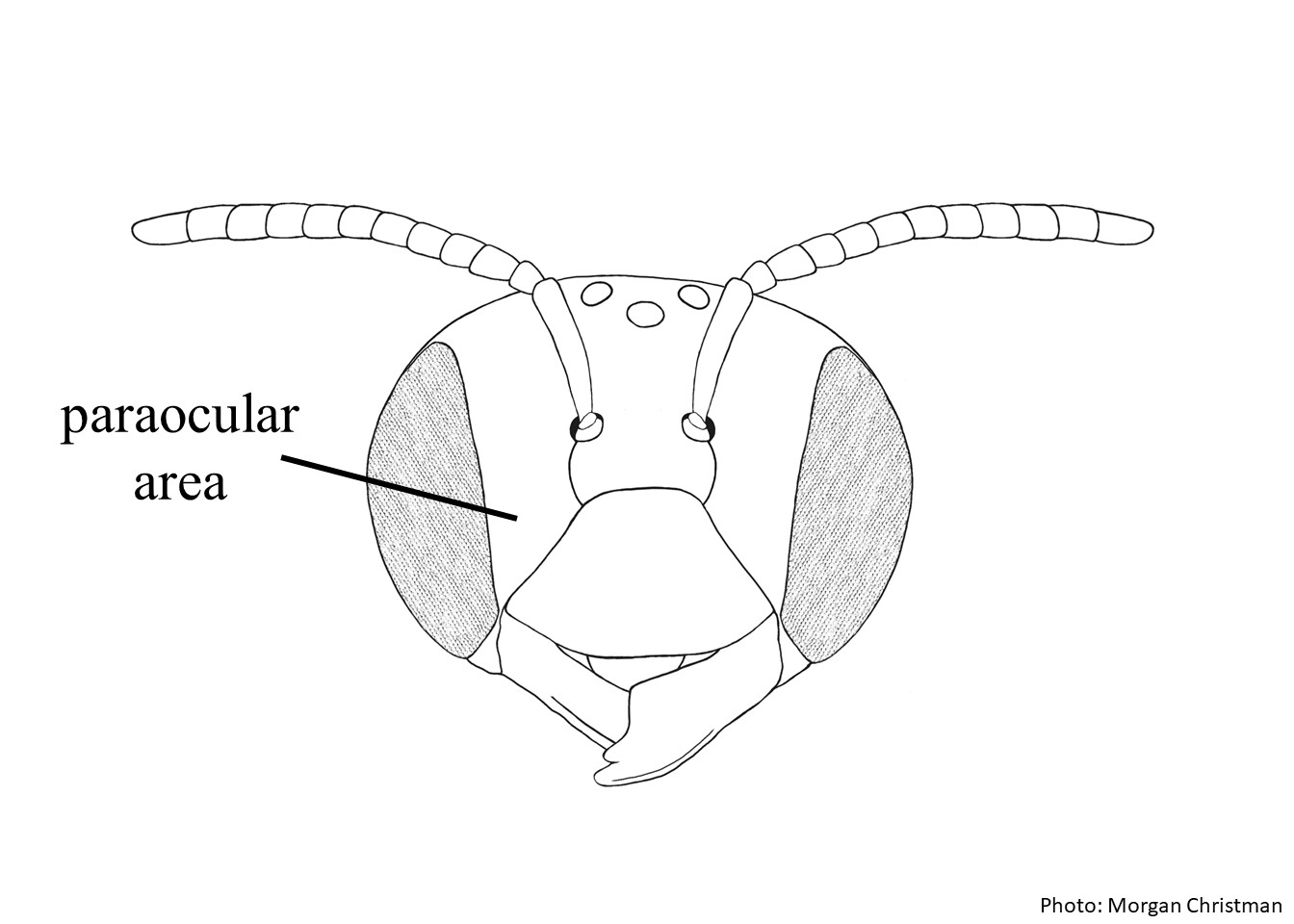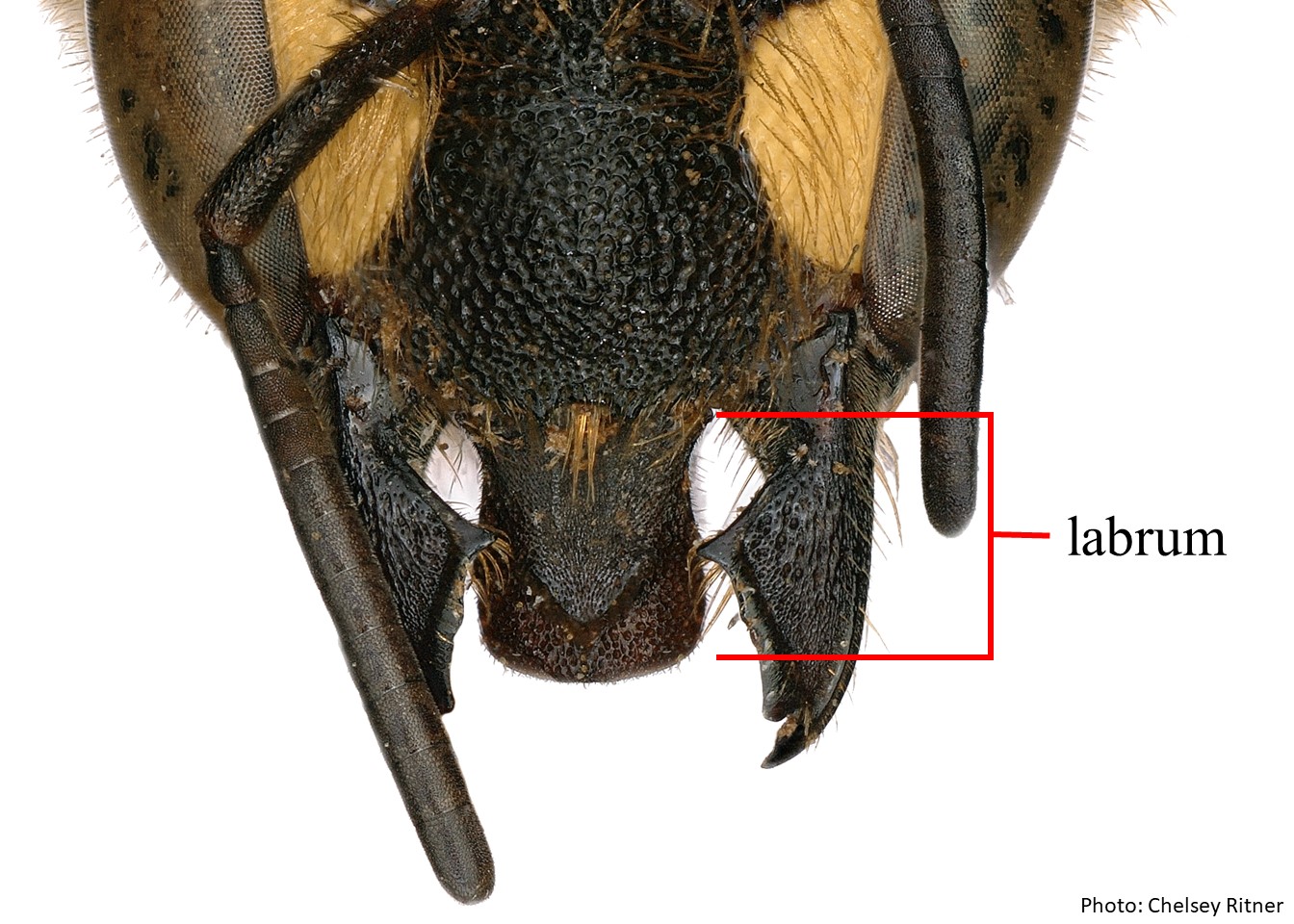Family: Megachilidae
Subfamily: Megachilinae
Tribe: Anthidiini
Genus: Anthidium Fabricius, 1804
Subgenus: A. (Anthidium) Fabricius, 1804
Species: Anthidium labergei Gonzalez and Griswold, 2013
Common name: none
Anthidium (Anthidium) labergei are dark brown to black with yellow maculations (Gonzalez and Griswold 2013Gonzalez and Griswold 2013:
Gonzalez, V.H. and T.L. Griswold. 2013. Wool carder bees of the genus Anthidium in the Western Hemisphere (Hymenoptera: Megachilidae): diversity, host plant associations, phylogeny, and biogeography. Zoological Journal 168: 221ndash;425.). The outer surface of the mandiblemandible:
bee teeth, so to speak, usually crossed and folded in front of the mouth, paraocular areaparaocular area:
the area extending along the sides of the face parallel to the eye
 , and clypeusclypeus:
, and clypeusclypeus:
a section of the face below the antennae, demarcated by the epistomal sutures are black with dispersed yellow spots. Females have white pubescencepubescence:
short, fine hair
, except for the yellow hairs found on the vertexvertex:
the area between the ocelli and the back of the head, scutumscutum:
the large segment on top of the thorax located between the wings and behind the head
, axillaaxilla:
the triangular or rounded point on the thorax where thoracic muscles meet the forewing of an insect, scutellumscutellum:
shield shaped plate behind scutum, and inner tarsitarsi:
the group of segments at the end of the leg following the tibia
. Females range in body length from 6.5–10.3 mm, and males range in body length from 9.2–10.5 mm (Gonzalez and Griswold 2013Gonzalez and Griswold 2013:
Gonzalez, V.H. and T.L. Griswold. 2013. Wool carder bees of the genus Anthidium in the Western Hemisphere (Hymenoptera: Megachilidae): diversity, host plant associations, phylogeny, and biogeography. Zoological Journal 168: 221ndash;425.).
(modified from Gonzalez and Griswold 2013Gonzalez and Griswold 2013:
Gonzalez, V.H. and T.L. Griswold. 2013. Wool carder bees of the genus Anthidium in the Western Hemisphere (Hymenoptera: Megachilidae): diversity, host plant associations, phylogeny, and biogeography. Zoological Journal 168: 221ndash;425.)
 lacks basalbasal:
lacks basalbasal: is straight in profile with a slightly swollen discdisc:
is straight in profile with a slightly swollen discdisc: preapical projections are larger than that in females.
preapical projections are larger than that in females. with median apicalapical:
with median apicalapical: apicalapical:
apicalapical: laterallateral:
laterallateral: distaldistal:
distaldistal: is notched on the apicalapical:
is notched on the apicalapical: apicalapical:
apicalapical: laterallateral:
laterallateral: median spine.
median spine. laterallateral:
laterallateral:Female A. labergei may be confused with A. collectum due to the lack of an anterioranterior:
toward the head or on the head side of a segment being described
carina on the hind tibiatibia:
the segment of the leg, between the femur and the tarsus, presence of basitarsibasitarsi:
the segment of the tarsus that is the nearest to the body of the bee, usually the largest of all the tarsal segments covered with dense tomentumtomentum:
a form of pubescence composed of short matted, woolly hair
, white sternal scopascopa:
modified hairs for carrying pollen; often branched and dense hairs on the hind-leg, or on the ventral surface of the abdomen in Megachilidae
, and dull tergaterga:
the segments on the top side of the abdomen, often abbreviated when referring to a specific segment to T1, T2, T3, T4, T5, T6, or T7 with somewhat dense punctationpunctation:
with somewhat dense punctationpunctation:
overall pattern of the punctures on a surface of a bee, includes size of punctures and the distance between them
(Gonzalez and Griswold 2013Gonzalez and Griswold 2013:
Gonzalez, V.H. and T.L. Griswold. 2013. Wool carder bees of the genus Anthidium in the Western Hemisphere (Hymenoptera: Megachilidae): diversity, host plant associations, phylogeny, and biogeography. Zoological Journal 168: 221ndash;425.). Female A. labergei and A. collectum can be differentiated from one another by the paraocular areaparaocular area:
the area extending along the sides of the face parallel to the eye
 with reduced or absent maculations, and overall finer punctations on the tergaterga:
with reduced or absent maculations, and overall finer punctations on the tergaterga:
the segments on the top side of the abdomen, often abbreviated when referring to a specific segment to T1, T2, T3, T4, T5, T6, or T7 in A. labergei (Gonzalez and Griswold 2013Gonzalez and Griswold 2013:
in A. labergei (Gonzalez and Griswold 2013Gonzalez and Griswold 2013:
Gonzalez, V.H. and T.L. Griswold. 2013. Wool carder bees of the genus Anthidium in the Western Hemisphere (Hymenoptera: Megachilidae): diversity, host plant associations, phylogeny, and biogeography. Zoological Journal 168: 221ndash;425.). Male A. labergei may be confused with A. palmarum due to the shape of S6S6:
the plates on the underside of the abdomen, often abbreviated when referring to a specific segment to S1, S2, S3, S4, S5, S6, S7, or S8
 and shape of the apicalapical:
and shape of the apicalapical:
near or at the apex or end of any structure
process on S8S8:
the plates on the underside of the abdomen, often abbreviated when referring to a specific segment to S1, S2, S3, S4, S5, S6, S7, or S8
 (Gonzalez and Griswold 2013Gonzalez and Griswold 2013:
(Gonzalez and Griswold 2013Gonzalez and Griswold 2013:
Gonzalez, V.H. and T.L. Griswold. 2013. Wool carder bees of the genus Anthidium in the Western Hemisphere (Hymenoptera: Megachilidae): diversity, host plant associations, phylogeny, and biogeography. Zoological Journal 168: 221ndash;425.). Male A. labergei can be differentiated from A. palmarum by the broad, rounded shape of the laterallateral:
relating, pertaining, or attached to the side
lobe on T7T7:
the segments on the top side of the abdomen, often abbreviated when referring to a specific segment to T1, T2, T3, T4, T5, T6, or T7 , S4S4:
, S4S4:
the plates on the underside of the abdomen, often abbreviated when referring to a specific segment to S1, S2, S3, S4, S5, S6, S7, or S8
 with median apicalapical:
with median apicalapical:
near or at the apex or end of any structure
margin more concave, S7S7:
the plates on the underside of the abdomen, often abbreviated when referring to a specific segment to S1, S2, S3, S4, S5, S6, S7, or S8
 hemisternite with a notched distaldistal:
hemisternite with a notched distaldistal:
place on a segment that is furthest from the place of attachment with the body
margin, and a hooked apicalapical:
near or at the apex or end of any structure
process on S8S8:
the plates on the underside of the abdomen, often abbreviated when referring to a specific segment to S1, S2, S3, S4, S5, S6, S7, or S8
 (Gonzalez and Griswold 2013Gonzalez and Griswold 2013:
(Gonzalez and Griswold 2013Gonzalez and Griswold 2013:
Gonzalez, V.H. and T.L. Griswold. 2013. Wool carder bees of the genus Anthidium in the Western Hemisphere (Hymenoptera: Megachilidae): diversity, host plant associations, phylogeny, and biogeography. Zoological Journal 168: 221ndash;425.).
Anthidium labergei adults have been recorded in flight from April to early May (Gonzalez and Griswold 2013Gonzalez and Griswold 2013:
Gonzalez, V.H. and T.L. Griswold. 2013. Wool carder bees of the genus Anthidium in the Western Hemisphere (Hymenoptera: Megachilidae): diversity, host plant associations, phylogeny, and biogeography. Zoological Journal 168: 221ndash;425.).
Anthidium labergei is a generalist that has been observed visiting a variety of species within Asteraceae, Boraginaceae, Brassicaceae, and Malvaceae (Gonzalez and Griswold 2013Gonzalez and Griswold 2013:
Gonzalez, V.H. and T.L. Griswold. 2013. Wool carder bees of the genus Anthidium in the Western Hemisphere (Hymenoptera: Megachilidae): diversity, host plant associations, phylogeny, and biogeography. Zoological Journal 168: 221ndash;425.).
Nesting behavior is unknown.
Anthidium labergei occur in the U.S. throughout southern Arizona, southern New Mexico, and western Texas (Gonzalez and Griswold 2013Gonzalez and Griswold 2013:
Gonzalez, V.H. and T.L. Griswold. 2013. Wool carder bees of the genus Anthidium in the Western Hemisphere (Hymenoptera: Megachilidae): diversity, host plant associations, phylogeny, and biogeography. Zoological Journal 168: 221ndash;425.). In Mexico, they are found in northern Sonora where their distribution is restricted to the Chihuahuan and Sonoran Desert ecoregions (Gonzalez and Griswold 2013Gonzalez and Griswold 2013:
Gonzalez, V.H. and T.L. Griswold. 2013. Wool carder bees of the genus Anthidium in the Western Hemisphere (Hymenoptera: Megachilidae): diversity, host plant associations, phylogeny, and biogeography. Zoological Journal 168: 221ndash;425.).
Distribution map generated by Discover Life -- click on map for details, credits, and terms of use.
Gonzalez, V.H. and T.L. Griswold. 2013. Wool carder bees of the genus Anthidium in the Western Hemisphere (Hymenoptera: Megachilidae): diversity, host plant associations, phylogeny, and biogeography. Zoological Journal of the Linnean Society 168: 221-425.